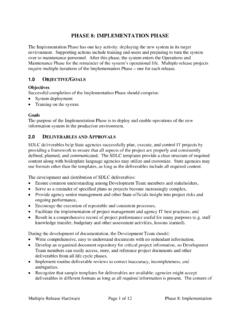Transcription of Instructional System Design (ISD): Using the ADDIE Model
1 Steven J. McGriff09/2000 Instructional Systems, College of Education, Penn State UniversityInstructional System Design (ISD): Using the ADDIE ModelInstructional Design is the systematic approach to theAnalysis, Design , Development, Implementation, and Evaluation of learning materials and Design aims for a learner-centered rather than the traditional teacher-centered approach toinstruction, so that effective learning can take place. This means that every component of the instructionis governed by the learning outcomes, which have been determined after a thorough analysis of thelearners phases sometimes overlap and can be interrelated; however, they provide a dynamic, flexibleguideline for developing effective and efficient TasksSample OutputAnalysisthe process of defining what is to belearned Needs assessment Problem identification Task analysis Learner profile Description of constraints Needs, Problem Statement Task analysisDesignthe process of specifying how it is tobe learned Write objectives Develop test items Plan instruction Identify resources Measurable objectives Instructional strategy Prototype specificationsDevelopmentthe process of authoring andproducing the materials Work with producers Develop workbook, flowchart.
2 Program Storyboard Script Exercises Computer assisted instructionImplementationthe process of installing the project inthe real world context Teacher training Tryout Student comments, dataEvaluationthe process of determining theadequacy of the instruction Record time data Interpret test results Survey graduates Revise activities Recommendations Project report Revised prototypeSan Jose State University, Instructional Technology ProgramAnalysisDesignDevelopmentImplemen tationSummative EvaluationFormative EvaluationThe ADDIE Modelis an iterativeinstructional designprocess, where theresults of theformative evaluationof each phase maylead the instructionaldesigner back to anyprevious end product ofone phase is thestarting product ofthe next J.
3 McGriff09/2000 Instructional Systems, College of Education, Penn State UniversityInstructional System Design (ISD): Using the ADDIE ModelAnalysisThe Analyze phase is the foundation for all other phases of Instructional Design . During this phase, youmust define the problem, identify the source of the problem and determine possible phase may include specific research techniques such as needs analysis, job analysis and task outputs of this phase often include the Instructional goals, and a list of tasks to be instructed. Theseoutputs will be the inputs for the Design Design phase involves Using the outputs from the Analyze phase to plan a strategy for developing theinstruction. During this phase, you must outline how to reach the Instructional goals determined duringthe Analyze phase and expand the Instructional of the elements of the Design Phase may include writing a target population description, conductinga learning analysis, writing objectives and test items, selecting a delivery System , and sequencing theinstruction.
4 The outputs of the Design phase will be the inputs for the Develop Develop phase builds on both the Analyze and Design phases . The purpose of this phase is togenerate the lesson plans and lesson materials. During this phase you will develop the instruction, allmedia that will be used in the instruction, and any supporting documentation. This may include hardware( , simulation equipment) and software ( , computer-based instruction).ImplementationThe Implementation phase refers to the actual delivery of the instruction, whether it's classroom-based,lab-based, or computer-based. The purpose of this phase is the effective and efficient delivery ofinstruction. This phase must promote the students' understanding of material, support the students'mastery of objectives, and ensure the students' transfer of knowledge from the Instructional setting to phase measures the effectiveness and efficiency of the instruction.
5 Evaluation should actually occurthroughout the entire Instructional Design process - within phases , between phases , and afterimplementation. Evaluation may be Formative or Evaluation is ongoing during and between phases . The purpose of this type of evaluation isto improve the instruction before the final version is Evaluation usually occurs after the final version of instruction is implemented. This typeof evaluation assesses the overall effectiveness of the instruction. Data from the Summative Evaluation isoften used to make a decision about the instruction (such as whether to purchase an Instructional packageor continue/discontinue instruction).This ADDIE Model descriptive summary was provided by three Graduate Students (Sherri Braxton,Kimberly Bronico, Thelma Looms) in the Computer Science Department at The George WashingtonUniversity in Washington, Available as of 9/23/00 at: ~sbraxton/









